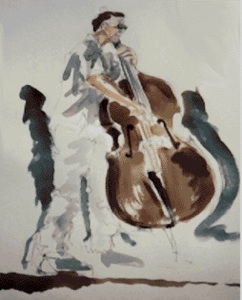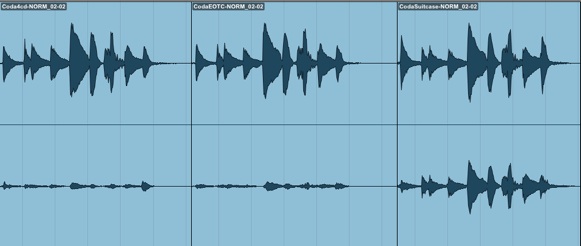Album Index Page 1 Page 2 Page 3 Page 4


At right, by clicking “View,” then “Open in iTunes,” you can hear the 90-second, free sample clips of “Without a Song” (track 6) and “I’ll Be Seeing You” (track 7), as available on iTunes. All samples (except one 5-second clip) presented for comparison on this page fall within those same 90-second sample windows, and are posted for discussion purposes only.
At right, by clicking “View,” then “Open in iTunes,” you can hear the 90-second, free sample clips of “Without a Song” (track 6) and “I’ll Be Seeing You” (track 7), as available on iTunes. All samples (except one 5-second clip) presented for comparison on this page fall within those same 90-second sample windows, and are posted for discussion purposes only.
About the samples on this page:
There have been two masterings of this title, and those masterings have been recycled a few times. In a nutshell, there is 1.) the original 1991 mastering, recycled for the 1993 set with a bonus track, and again in the 1995 “suitcase” set; and 2.) the 1998 mastering for the EOTC series. Both appear to be handled by Lee Herschberg, although he was not publicly credited until the 1993 set. Thanks to SH.TV members Bob F and MMM for sharing clips.
FIRST: The first mastering. Click: 1993 CD Clip.mp3 SECOND: The later EOTC mastering. Click: IBC EOTC Clip.mp3
(Note: Because the EOTC is less dynamic than the 1993 disc, be sure to adjust your listening volume to avoid the age-old pitfall of “louder = better.”
Compact Discs
Above: the dynamic differences between the 1991 and 1998 EOTC masterings.
The 1991 and 1998 masterings do not play in sync, so they appear to not be mere tweaks of the same digital source, but legitimately different masterings from different transfers, and there are some significant, audible differences between the two. Below is a clip with a few repeated segments. In each pairing, the 1993 mastering is heard first, followed by the 1998 EOTC remastering. Click: IBC 1993-1998 alternating.mp3
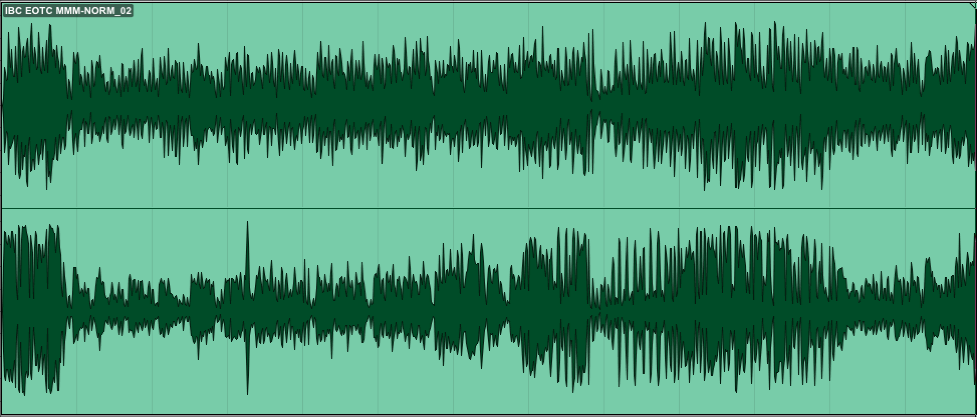
One of the more intriguing differences to me is that something sounds fragmented or sloppy on that 1991/93/95 mastering, even though I much prefer the tone and dynamics of it compared to the 1998 EOTC version. It’s odd that I posted on SH.TV that the 1991 mastering was like a wet piece of bread that wouldn’t stay together when nailed to the wall, and our friend MMM stated that he felt the 1991 mastering was “watery.” There’s something just off-kilter about it, apparently in a way that makes people envision something liquid-y, despite the fact that it has pretty good tonal balance, i.e., decent full-range sound with good highs and appropriate bass levels, and basically-good vocal tone. I think that I may have figured out what part of the problem is, and it’s a general smeariness to the stereo effect, especially audible in the location of the bass within the stereo image. LISTEN BELOW (click on the picture) to a clip that goes back and forth between the 1991 and EOTC masterings, and ignore (for now) the tonal differences, and focus instead on the location of the bass in the mix.
To my ears, the bass is shifting from a somewhat not-hard-panned-far-left location on the 1993 version to a 100% far-left location on the 1998 version. Think about that for a minute. This is a 3-track recording. Let’s refer to them as left, center, and right tracks, just to be conversational. The left track contains half of the orchestra, the right track contains the other half, and the center track is for vocals. In other words, since the bass is an instrument, it has to be either hard left of hard right on the original session tracks. If the bass is moving toward the middle, it is doing so with the “help” of well-after-the-fact electronics. It’s being artificially steered to the middle, either intentionally or as an unintended by-product. It’s a distortion of what’s on the tapes.
One must now ask the question: Which is truer to the original LP? The 1991, or the 1998? To my ears, the 1991 release does a very good job of recreating the tone, dynamics, and spectral balance of the 1961 stereo LP, but does a poor job at recreating the super-wide stereo image, i.e,. left-to-right balances. On the other hand, the 1998 CD has a stereo image that is virtually identical to the stereo LP, but with tone that is rolled off on top and bloated in the bass.
Next is a clip that plays in this order: 1. 1991 mastering; 2. R9 stereo LP; 3. 1991 mastering; 4. R9 stereo LP. Click: IBC 1993-R9-1993-R9.mp3
Next is a similar clip, but alternating between the 1998 CD and the R9 stereo LP: IBC 1998-R9-1998-R9.mp3
Is it a remix?
I don’t see how a simple remastering of the same stereo tape gets a right-channel (drum) level difference such as that. In my opinion, that has the be a remix, and it sounds like a different mix. Remember, there only three tape tracks to “dink with:” 1. Orchestra left; 2. Orchestra right; 3. Vocal; so to get a mix that sounds in the ballpark of the original mix should be relatively easy to do, and this one sounds somewhat in the ballpark of the original mix, but to my ears, it’s not that original mix.
•Finally, there’s the “mixing move” that I hear on the original mix, but not on the CDs. I think it’s a case of the vocal track being quickly faded up just before Frank enters, and it’s audible right on the 4th of 4 snare drum taps, “tap.... tap tap TAP.” It’s on that last TAP, and you’ll hear the stereo image move to the middle right on that final tap. (I used my own R9 original stereo pressing, but the same quirk is on all the stereo LP samples, as well as on my original RSL Ampex reel.)
Below, you will hear 8 very brief snippets (with a space at one point), as follows:
-
1.R9 stereo - TAP = move to center
-
2.Repeat of same
-
3.Repeat of same
-
4.1993 CD -- No move to center
(Space inserted after 4)
-
5.R9 stereo - TAP = move to center
-
6.Repeat of same
-
7.Repeat of same
-
8.EOTC CD -- No move to center
Listen: MixMoveSamples.mp3
I can’t say for certain, but I’m leaning this way:
•1991 CD? A remix, start to finish. Aside from the bits and piece of aural evidence, there’s the over-arching impression that it sounds “off.”
•1998 CD? I think it’s the original mix, but with a little cleanup work in spots, OR it’s another Herschberg remix along the lines of Ring-a-Ding Ding that is so well done that it sounds virtually identical to the original, more of a “re-creation” than a remix. (These Reprise EOTC editions are hard to pin down.)
Let’s move on to the “winners page.” Click here. Please join the discussion of this album at the Steve Hoffman Music Forum.
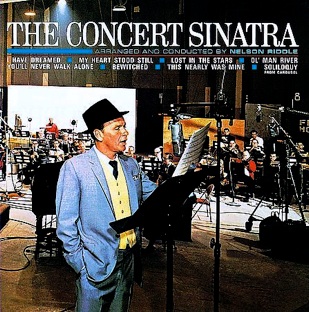
In January of 2012, there was some fairly heated discussion in the Steve Hoffman Music Forum amongst a bunch of us Sinatra nuts as to whether or not the 1998 “Entertainer of the Century” CD of The Concert Sinatra was a remix from the 3-track reduction tapes or simply a remaster from the stereo mix tape. (You may want to scan through that thread, starting about here.) In the end, I’m not sure that we came up with a 100% definitive answer, although there was no denying that one track, “Lost in the Stars,” definitely had to involve a remix,
as the vocal line at the end was held out markedly longer vis a vis all other editions of the same recording. Personally, after much careful listening, much dialogue with Sinatraphiles, and much consternation, my final opinion -- which I’ll admit goes against convention a bit -- was that five tracks were not remixed, while three were partially or fully remixed, basically amounting to a well-done repair job rather than a full-on, from-scratch overhaul.
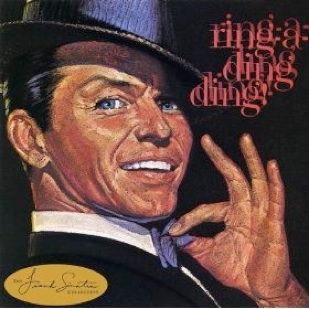
Similarly, the 1991 CD release of Ring-a-Ding Ding had even the most seasoned audioheads confused about the provenance of the mix used. (See discussion starting here.)
I bring this up because the CDs of I Remember Tommy seem to pose a similar remix uncertainty. To my ears, the initial CD release (1991, reused in both 1993 and 1995) is a remix, and not an especially good one, frowned upon for reasons outlined a few paragraphs back. The 1998 EOTC disc, though, is another conundrum along the lines of the same series’ The Concert Sinatra release, and I suspect we once again have a patchwork
job, largely consisting of the original mix, with some repair work done as needed. The evidence (as I see it) follows, in several not-fully-related pieces.
•The original mix has the instruments panned fully hard left and hard right (in roughly even-and-balanced forces), fairly dry (in instrumental reverb terms), with a centered vocal track that has a small amount of reverb applied. Here is a sample that features the same brief vocal clip from three sources, in this order: 1.) Original R9 stereo pressing; 2.) 1990’s “The Reprise Collection” 4-CD set, which uses the same original mix; and 3.) The 1998 EOTC edition. Listen: WithoutASongR9-4CD-1998.mp3. OK, I’ll accept those as all being the same mix. Now listen to the three clips, in this order: 1.) Original R9 stereo pressing; 2.) 1990’s “The Reprise Collection” 4-CD set; and 3.) The 1991/93/95 mastering: WithoutASongR9-1990-1991.mp3. Remix or not, it’s a different landscape on that 1991 version, something you can double check by comparing the CD samples at the top of this page.
•The 1993/1995 version has a very different sound. Specifically, the instruments are no longer 100% far left and far right, but appear to be mildly steered inward a bit, at least in the lower frequencies. (The upright bass frequencies really stand out as being artificially steered inward. See cartoon image and accompanying text and audio, about 9 paragraphs above.) Also, there is heavy reverb added, with a markedly brighter vocal tone. Again, I direct you to the comparisons at the top of this page.
•There are subtle differences in terms of channel balance that, in my view, would not be attributable to a simple change in mastering, but point to a different mix. For instance, here are waveforms for the piano/bass/drums coda that concludes “It Started All Over Again.” The drums are in the right (lower) channel, with levels that are vastly different than in the other two CD versions. Note that the order shown below is: 1.) 1990 4-CD set (original mix?); 2.) 1998 EOTC CD (original mix?); 3.) earlier 1993 CD (remix?). Click the waveform to listen.
